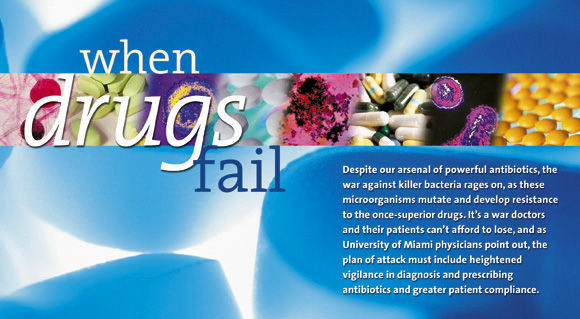
BY DAVID VILLANO
![]() his cannot be how the future of medicine was imagined
back in 1928, the year Scottish bacteriologist Alexander Fleming
peered into his petri dish and noticed a bacteria-free ring surrounding
a growth of mold spores. Fleming's discovery-penicillin-promised
to forever change the treatment of infectious disease. Those
pre-World War II scientists and futurists must have imagined
that today, at the brink of the millennium, many of the human
body's most potent killers would be wiped out, ushering in an
era of unprecedented health and prosperity.
his cannot be how the future of medicine was imagined
back in 1928, the year Scottish bacteriologist Alexander Fleming
peered into his petri dish and noticed a bacteria-free ring surrounding
a growth of mold spores. Fleming's discovery-penicillin-promised
to forever change the treatment of infectious disease. Those
pre-World War II scientists and futurists must have imagined
that today, at the brink of the millennium, many of the human
body's most potent killers would be wiped out, ushering in an
era of unprecedented health and prosperity.
That promise has fallen a bit short. While penicillin and other antibiotics have revolutionized the treatment of many diseases, we still live in a world of killer bacteria. As many as 80,000 people die in the United States annually from staph infections; an estimated 3.5 million die each year worldwide from tuberculosis (TB); and pneumonia remains a serious health complication in developed and underdeveloped areas alike.
Our mistake, of course, has been to underestimate the resourcefulness of bacteria. Our attempts to eradicate harmful varieties have led to an all-out guerrilla warfare. Bacteria's strategy: keep changing, mutating, developing resistance to the drugs we deploy against them. In time, our weapons are rendered useless. Bacteria is winning the war.
"The problem of drug resistance threatens to reverse all the successes we have worked so hard for," says Margaret Fischl, M.D., professor of medicine and director of the AIDS Clinical Research Unit at the School of Medicine. "Attack-ing this problem could be the greatest challenge in medicine today."
![]() n
the 1940s, when antibiotics first became commercially available,
few people could have foreseen our predicament. Penicillin was
truly a wonder drug. But like all good things, too much of it
can cause trouble. In 1987 the National Institutes of Health
concluded that the emergence of drug-resistant bacteria is directly
caused by the incorrect and excessive use of antibiotics.
n
the 1940s, when antibiotics first became commercially available,
few people could have foreseen our predicament. Penicillin was
truly a wonder drug. But like all good things, too much of it
can cause trouble. In 1987 the National Institutes of Health
concluded that the emergence of drug-resistant bacteria is directly
caused by the incorrect and excessive use of antibiotics.
The problems are many. Bacteria become resistant to drug therapy when they mutate into varieties that are able to avoid or combat antibiotics. Sometimes they do this by changing their molecular structure; other times by attacking the antibiotic itself. Such mutations are an evolutionary inevitability. But the rate of mutation is directly related to the bacteria's exposure to the antibiotic. The more the exposure, the quicker the rate of mutation. We have accelerated that rate by overprescribing the drugs.


While health care workers have long been aware of the problem,
misuse and abuse of antibiotics persist. According to a 1997
study published in the Journal of the American Medical Association,
one in five antibiotic prescriptions in the United States-totaling
more than 12 million-were written for ailments that do not respond
to such drugs. For example, researchers found that physicians
were prescribing antibiotics for two-thirds of bronchitis sufferers
and more than half of common cold sufferers.
Of course physicians aren't the only culprits. Patients often demand the drugs for colds, flu, and other viruses that are not affected by antibiotics. Some patients, believing they can endlessly ward off disease, obtain prescriptions for ongoing, prophylactic antibiotic use. Many physicians give in to such demands rather than argue with the patient.
Overreliance on antibiotics-even when properly prescribed-also contributes to the drug resistance crisis. For example, Gwen Wurm, M.D., an assistant professor of clinical pediatrics at the University, says even though many childhood ear ailments heal just as quickly without antibiotics, many physicians prescribe drugs at the slightest onset of infection. The emergence of managed care's cost-containment strategies may be exacerbating the problem.
"The cheapest and easiest thing to do is to write a prescription for antibiotics and never see the patient again," says Wurm. "The alternative is to explain about the infection, explain why antibiotics aren't the best course of treatment, explain what parents should look out for in their child, and then have a follow-up visit in 48 hours."
![]() ompounding
the problem is the seductive allure-and intensive marketing-of
ever-more powerful drug companies. Although infections, when
possible, should be treated with drugs that attack the harmful
bacteria only, many physicians opt for broad-spectrum antibiotics
that may kill many other varieties. The body's exposure to such
antibiotics increases the odds of producing resistant mutations.
Mark Multach, M.D., associate professor of medicine and chief
of general internal medicine at the University of Miami, says
everyone plays a key role, including the pharmaceutical companies
who must bear some of the blame. "Doctors are barraged with
information from drug manufacturers saying that their drug works
best in this situation or that situation," says Multach.
"But is it really true? Just because a drug works doesn't
necessarily mean it is the best choice for a given condition."
ompounding
the problem is the seductive allure-and intensive marketing-of
ever-more powerful drug companies. Although infections, when
possible, should be treated with drugs that attack the harmful
bacteria only, many physicians opt for broad-spectrum antibiotics
that may kill many other varieties. The body's exposure to such
antibiotics increases the odds of producing resistant mutations.
Mark Multach, M.D., associate professor of medicine and chief
of general internal medicine at the University of Miami, says
everyone plays a key role, including the pharmaceutical companies
who must bear some of the blame. "Doctors are barraged with
information from drug manufacturers saying that their drug works
best in this situation or that situation," says Multach.
"But is it really true? Just because a drug works doesn't
necessarily mean it is the best choice for a given condition."
Not surprisingly, the spread of antibiotic-resistant bacteria is reaching epidemic proportions. In the mid-1980s the rate of penicillin-resistant streptococcal bacteria (a leading cause of pneumonia) was less than one-half percent. Today the figure is upwards of 30 percent. Drug-resistant TB also has skyrocketed. Fischl, who often sees the disease as a complication in HIV patients, was on the frontline of a deadly outbreak of multidrug resistant TB in Miami-Dade County in the early 1990s. A similar outbreak occurred in New York City. Fischl says the epidemics may have been initiated by a low rate of drug therapy compliance by TB patients. When patients interrupt a course of antibiotics, the surviving bacteria return with a vengeance, often having rapidly mutated to resist the therapy.
Clearly, the war on bacteria is not over. With the proper use of antibiotics, through improved health care protocols, drug-resistant strains will be fewer and less virulent. To begin with, Multach suggests, physicians must be more vigilant about identifying specific infections and prescribe specific antibiotics. "It may require a bit of extra work and may be a bit more expensive, but a doctor needs to find out exactly what an infection is and then find out what really works best," says Multach. "These fancy new drugs are usually not the way to go."
Wurm agrees. She encourages physicians to think twice before prescribing any antibiotic. If necessary, patients who seem unduly enamored of antibiotics should be educated on the alternatives. "It's not clear that every infection needs an antibiotic," says Wurm. "The human body is set up to fight infections so there's no reason to call in the cavalry until we suspect we're losing the battle."
But once antibiotics are prescribed, patient compliance is vital. Fischl, who helped mount a response to Miami's multidrug-resistant TB outbreak, says everything possible must be done to ensure that patients complete their course of treatment. In Miami-Dade, she says, the most important weapon in the war against TB has been Direct Observational Therapy or DOT. Through DOT programs, health care workers are dispatched into the community-to private homes and clinics-to administer and supervise drug therapies. In many cases they simply observe a patient swallowing pills.
DOT is expensive, but so is the treatment of drug-resistant infections. A recent study estimated the combined cost of treating patients with drug resistance complications at $30 billion a year in the United States alone. "There's no easy, quick solution," says Multach. "But we really can't afford to ignore the problem any longer."
![]()
The Ultimate Weapon: Prevention
![]() t's an
increasingly common scenario. A patient is prescribed drugs for
a particular illness but they are taken so long that they lose
their effectiveness. Drug resistance has set in. The alternative?
Develop a vaccine to prevent an illness from ever occurring.
t's an
increasingly common scenario. A patient is prescribed drugs for
a particular illness but they are taken so long that they lose
their effectiveness. Drug resistance has set in. The alternative?
Develop a vaccine to prevent an illness from ever occurring.
"It's always better to prevent than to treat," says Gunter Kraus, Ph.D., assistant professor of microbiology and immunology at the School of Medicine. "Both scientifically and economically, it makes more sense to develop vaccines that have the potential to eradicate a condition, than to develop drugs that could amount to lifelong treatment."
 Dr.
Kraus is leading a research team in developing an AIDS vaccine,
a study funded by the National Institutes of Health.
Dr.
Kraus is leading a research team in developing an AIDS vaccine,
a study funded by the National Institutes of Health.
Another breakthrough in the fight against drug resistance is the ability of these vaccines to apply to any organism-bacterial or viral. Many patients have a misconception that, when a "bug" sets in, they need antibiotics, despite their doctor's diagnosis of a viral infection. Antibiotics, which only treat bacterial infections, are often requested by adults who refuse to heed their doctors' directives that the drugs are unnecessary. The development of future vaccines that address viral conditions may reduce antibiotic overuse. Annual flu vaccines have already helped decrease the usage.
The vaccine development process used by Dr. Kraus differs from the more commonly known process in which weakened cells from a virus (live attenuated virus) are administered to stimulate the immune system to fight off the virus if later encountered.
Instead, Dr. Kraus will use a viral DNA model that transforms the patient's own cells to stimulate the immune system-as opposed to introducing external stimulants. The immune system then sends the body's natural disease-fighting cells, known as T-cells, to respond.
DNA vaccines are more practical than attenuated viruses. "Room temperatures can inactivate an attenuated virus, making refrigeration necessary to get it to a vaccination site. DNA is stable, so no cooling is required, which makes the cost factor a big advantage for this particular application."
-Rebecca Morris Riordan
![]()
![]()
![]()
![]()
![]()